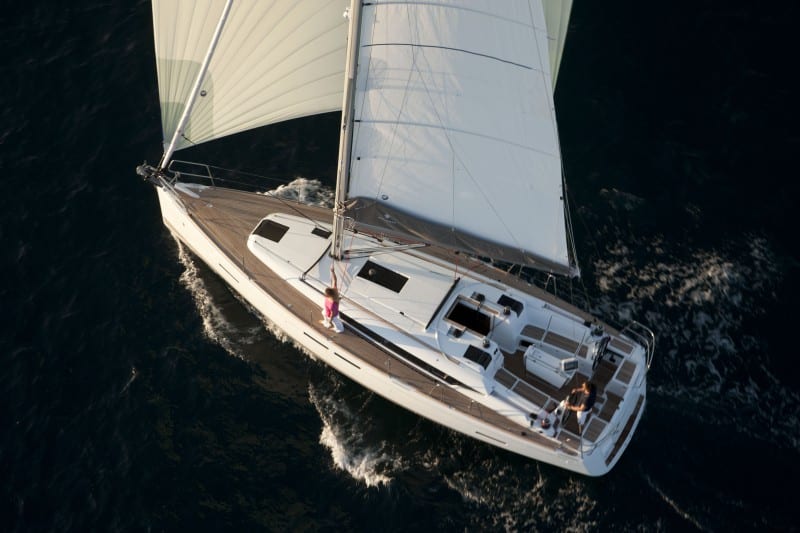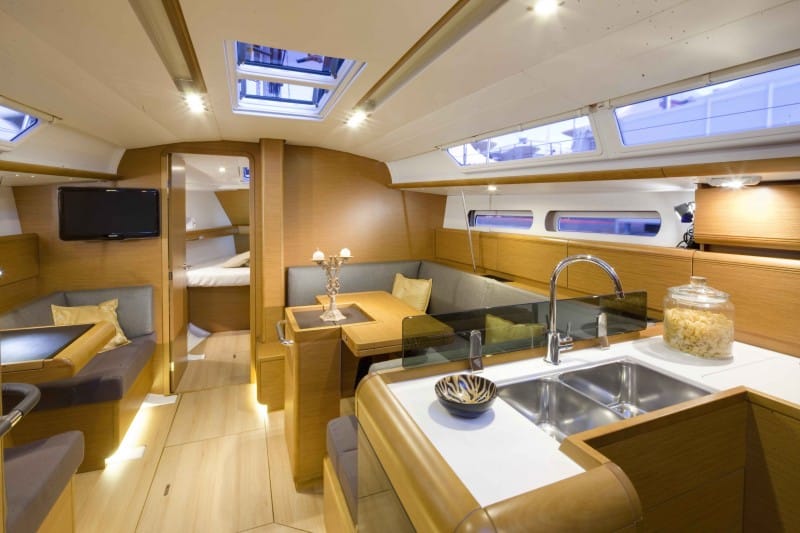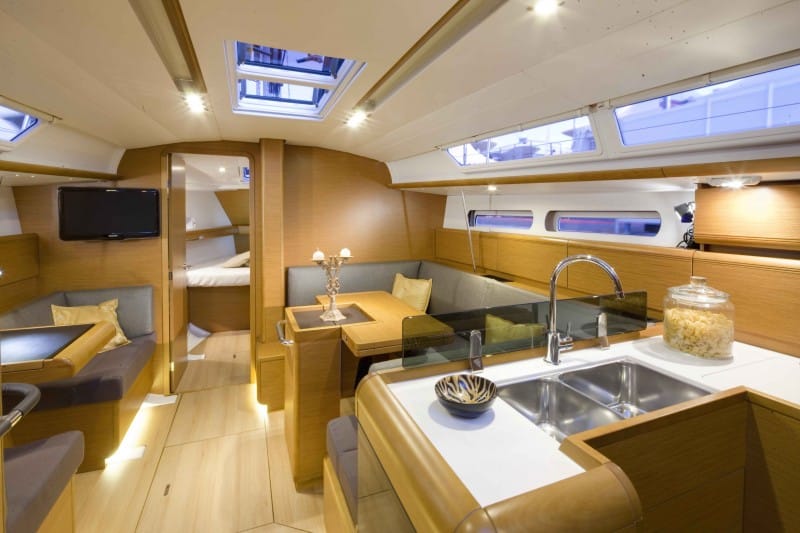
Last fall in a gentle southeasterly, I and two other Cruising World Boat of the Year judges sailed hull number four of the new Jeanneau Sun Odyssey 409 model on Chesapeake Bay. Considering that she replaces the 39i, of which well over 1,000 were built, I felt that we were witnessing the beginning of something big.
The 409 puts a host of innovative details on a relatively conventional platform—with just one exception. While the hull’s basic dimensions are consistent with a typical modern cruising boat, the Jeanneau Sun Odyssey 409 has a hard chine running from about amidships aft. Having gone many years without seeing a single crease in the hull of a new composite boat, we were surprised in this year’s new-boat fleet to find three, all from Groupe Beneteau. Compared with that of the Beneteau First 30 and the Beneteau Sense 50, the hard chine of the 409 occurs higher in the topsides, where it will confer more interior volume in the aft cabin and extra form stability under sail.

Immediately noticeable under sail is the refined thinking that Philippe Briand and the Jeanneau Sailboats Design Team have invested in the deck layout. It wasn’t very long ago that BOTY judges were lamenting the way that work stations were scattered all across the cockpits of new boats, from the coamings to the cabintops, making it difficult to sail shorthanded. No more. On the 409, as well as on many other of this year’s fleet, we were happy to see sailhandling lines and winches laid out within easy reach of the helm.
“The exciting thing here is the winches,” said BOTY judge Beth Leonard. Indeed, the Jeanneau Sun Odyssey 409 was said to be the first boat in the U.S. market to sport Harken’s new Rewind Radial Electric Winches. In one setting, you can use the two buttons in a high-speed/low-power mode or a slow-speed/high power mode—so far, just like any other electric winch. But by flipping a switch on the winch drum, you can do what no production-boat electric winch has let you do before: ease a line under load, safely and easily, without stripping it from the self-tailer. Harken’s new radial drum design promises to prevent overrides as well.
This boat had a single winch installed at each of the two helm stations, port and starboard. We would’ve liked to have had a third winch dedicated solely to the mainsheet. The boat we sailed was laid out with a double-ended mainsheet, each end of which runs aft through a stopper to the winch near the helm station. Because it shares the winch with the genoa sheet, which is always made fast to leeward, we were compelled on every tack or jibe to move the mainsheet to the windward winch. Especially when you’re jibing, you don’t want to rely on a closed sheet stopper while you clear the leeward winch for the genoa sheet. It’s a small quibble in an otherwise lovely working layout.
Overall, the large cockpit will happily accommodate half a dozen sailors under sail, and the cockpit won’t be engulfed in sailhandling spaghetti. “You could see a lot of people hanging around in the cockpit, playing back and forth, and having a good time,” said Beth. A removable helm seat opens the transom to the swim platform at anchor, with wet stowage below the cockpit sole for a life raft or diving gear, depending on how you use the boat.
“I was pleased with the performance of the boat,” said BOTY judge Ed Sherman, having sailed at 6.1 knots into 10 knots of true wind. A 40-horse Yanmar provided plenty of power to push the 409 along at 7.5 knots. In terms of noise under power, the boat was smack-dab in the middle of the fleet: 88 decibels at 2,600 rpm; 91 decibels at 3,000 rpm.
An optional performance package adds upgraded standing and running rigging, as well as tracks and cars on the side decks to accommodate a 140-percent triradial genoa made of laminated Mylar. Another option is a self-tacking jib, with a curved lateral track set forward of the mast.
Like other Jeanneaus, the interior of the 409 is a model of flexibility. The boat we sailed featured two cabins and one head, but a three-cabin layout is also available. That flexibility should appeal to private owners with or without kids, or to charterers.
Hull construction on this Jeanneau is no different from its elder siblings: solid hand-laid fiberglass. The cored decks are resin-injected—a process that involves two molds and produces two finished sides, inside and out. It’s more capital-intensive than hand layup, but it saves dozens of labor hours. The cast-iron keel comes in a 6-foot-10-inch standard version or a 5-foot-1-inch shoal version.
Until recently, all Jeanneaus were built in France. Although the particular 409 we sailed was French-built, this and other models are slated to be produced at the company’s production facility in Marion, South Carolina.

In a creditable nod to the times we’re living in, the 409 is the first Jeanneau that offers solar panels—two panels of 45 watts each—as a factory-installed option. That, plus efficient LED lighting throughout the entire boat and a low-draw Frigoboat refrigeration system with a three-stage compressor, demonstrates Jeanneau’s commitment to renewable energy systems.
“I give them credit,” said Ed. “They’re thinking about power consumption.”
After a thorough inspection, it was clear to all of us that they were thinking about a lot of things.
Tim Murphy, a Cruising World_ editor at large and 2011 Boat of the Year judge, is based in Portsmouth, Rhode Island._
Specs
LOA 40′ 5″ (12.32 m.)
LWL 36′ 1″ (11.00 m.)
Beam 13′ 1″ (3.99 m.)
Draft (shoal/deep) 5′ 1″/6′ 10″ (1.55/2.08 m.)
Sail Area 849 sq. ft. (78.9 sq. m.)
Ballast (shoal/deep) 5,445 lb. (2,470 kg)/ 4,982 lb. (2,260 kg.)
Displacement 16,424 lb. (7,450 kg.)
Ballast/D .33
D/L 156
SA/D 20.98
Water 140 gal. (530 l.)
Fuel 53 gal. (200 l.)
Holding 21 gal. (79 l.)
Mast Height 59′ 0″ (17.98 m.)
Engine 40-hp. Yanmar diesel
w/ saildrive
Designer Philippe Briand Yacht Design/ Jeanneau Design Team
Price $250,000
Jeanneau America
(410) 280-9400
www.jeanneau.com








